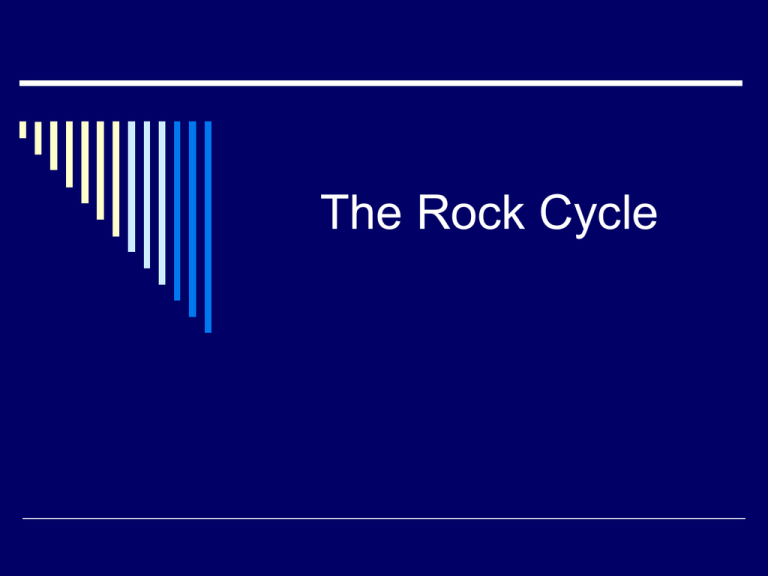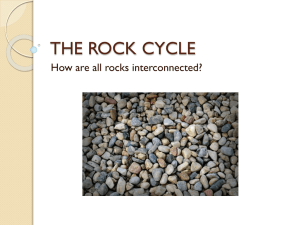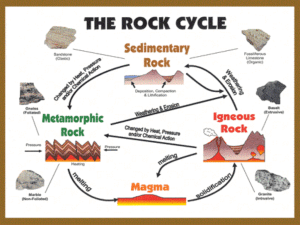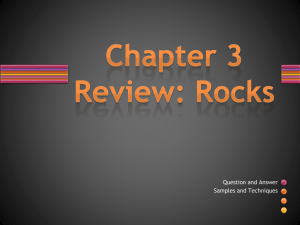The Rock Cycle
advertisement

The Rock Cycle The Rock Cycle Through many different geologic processes, the rocks that make up the earth’s crust form, change, get destroyed, and re-form over and over again. This is why it is called the rock CYCLE. There are constructive forces and destructive forces that drive the cycle. The Beginning Find “magma” on your rock cycle diagram. ALL rocks start as magma, thus the rock cycle begins in the earth’s interior where magma is still in the liquid state. It is placed at the bottom of this diagram because magma is found underground. Will not always be at the bottom of all rock cycle diagrams! The First Process As magma reaches the crust it is exposed to cooler temperatures and will harden. This is called crystallization Once crystallization has occurred, the magma is “hard as a rock.” This is a constructive force of nature. Igneous Rock Rocks that are formed directly from cooled magma are classified as igneous rocks. If the magma crystallized on the surface of the crust (on land), it is called extrusive igneous rock. If the magma crystallized while still in the crust (underground), it is called intrusive igneous rock. Examples Some examples of igneous rocks are: Intrusive: Granite, gabbro, quartz (also a mineral) Can usually see crystals or “specks” in the rock and mutlicolored Extrusive: Basalt, obsidian, scoria (“lava rock”) Usually one color without visible crystals, sometimes have many holes or porous Next Process Once igneous rocks are formed they become exposed to the elements on the surface of earth. wind, rain, temperature changes, sun exposure This exposure causes: Weathering – breaking into pieces Erosion – being moved (washed / blown away) to another location Lots and Lots of Little Pieces Once the destructive forces of weathering and erosion have occurred, sediments are formed. Dirt or soil, sand, silt, mud are all examples of sediments that have piled up after erosion Plants would not survive without this part of the rock cycle! No plants = no animals! The Third Process Sediments pile up in low areas after erosional forces have slowed or stopped. This is called deposition. As deposition continues, layers of sediments continue to pile up, and they compact the layers on the bottom. This is called compaction. Once compaction occurs, the sediments begin to “glue” together which is called cementation. (like the word cement) Third Process Continued These constructive forces of… Deposition Compaction Cementation …are all steps in what is called lithification- the process of loose sediments turning into rock. Once sediments lithify, new rock forms Sedimentary Rocks After lithification of the sediments, the rocks that are formed are classified as sedimentary rocks. Sedimentary rocks are the only type of rock that fossils are found in because of the way they form. Examples Sedimentary Rocks are often coarse in texture and have layers, and or visible grains Common sedimentary rocks are: Sandstone Chert (flint rock) Conglomerate Limestone Shale The Fourth Process Because of the way sedimentary rocks form, they usually get pushed further and further down into the crust from sediments continuing to layer on top. The deeper the sedimentary rocks get in the crust, they are exposed to increasing heat and pressure. Fourth Process Continued This increase in heat & pressure changes the rock, a lot like pressing 2 colors of playdough together…they’ll eventually mix colors. This change in the rock due to high heat and pressure is called metamorphism, (both a destructive and constructive force) and a new type of rock is formed. Metamorphic Rock The process of metamorphism creates the rocks classified as metamorphic rocks. Only occurs deep in the crust or near volcanoes where there is high enough temperatures and pressure. Therefore most metamorphic rock is found deep underground or near volcano sites. Examples All metamorphic rocks have a “parent rock,” or the original igneous or sedimentary rock it came from. Common metamorphic rocks: Slate (parent rock = Shale) Marble (parent rock = Limestone) Gneiss (parent rock = Granite) Last Process If metamorphic rocks remain deep underground they eventually get pushed so far down that they begin melting back into the magma. This last destructive force completes the rock cycle. The whole thing can then start all over! Loops within the Rock Cycle If an igneous rock remains underground, it will go through metamorphism and turn into metamorphic rock. If sedimentary or metamorphic rocks are exposed to the surface of the crust, they will experience weathering and erosion and turn into sediments.









